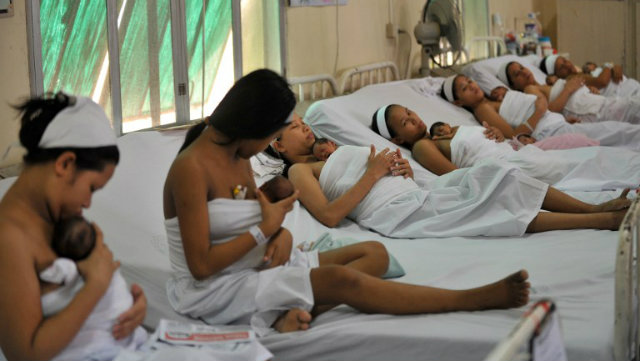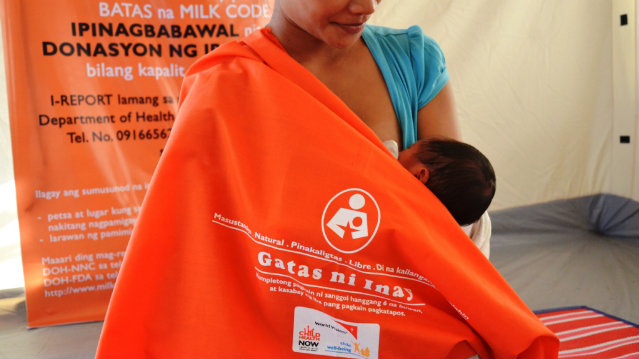SUMMARY
This is AI generated summarization, which may have errors. For context, always refer to the full article.

MANILA, Philippines – About 3 in every 10 children, aged 6 months to 5 years old, are suffering from chronic undernutrition in areas heavily damaged by Typhoon Yolanda (Haiyan), according to a post-Yolanda nutrition survey.
The February to March survey was done by the Nutrition Cluster. It was led by the government, with members from local and international non-governmental organizations (NGOs), as well as bilateral organizations responding to Yolanda-hit areas.
Chronic undernutrition, otherwise known as “stunting,” affects more than just the physical growth of a child.
Studies show that if left unsolved, it hinders children from reaching their full potentials. It can damage their cognitive development which affects school performance, and later productivity in adult life.
Worse, undernutrition combined with illness and infections is lethal. Afterall, undernutrition contributes to 45% of all under-5 deaths.
Preventive measures against stunting
Chronic undernutrition is a prolonged case of poor nutrition, starting from pregnancy, up to two years old. (WATCH: Peter Pan and never growing up)
Sadly, undernutrition during this period is irreversible. Solving undernutrition for children older than 2 years old will not repair the damage in growth faltering.
The first 1,000 days in the life of a child is therefore aptly dubbed the “window of opportunity” because this is when easy and inexpensive sources of infant and young child nutrition can have the most contribution to a child’s growth and development.
World Vision, through its Child Health Now Campaign, calls on government to prioritize prevention of undernutrition through effective infant and young child nutrition, particularly for the first 1,000 days.
The Child Health Now Campaign is World Vision’s first global advocacy campaign that aims to contribute to Millennium Development Goal (MDG) 4 which commits to the decrease in preventable child deaths.
As undernutrition contributes to nearly half of all preventable child deaths, Child Health Now sees good nutrition as the best start to help children reach their 5th birthday.
The latest rate of stunting in the Philippines is at 33.6%, or at least 3 in every 10 children.
Child Health Now in the Philippines works with the national and local governments and the nutrition coalition of NGOs for the prevention of chronic undernutrition.
The Child Health Now Campaign calls on the Philippine government to:
- Commit and follow through on the Scale Up Nutrition (SUN) Movement to create an enabling political environment, stronger leadership, and cohesive partnership with nutrition-focused civil society organizations
- Intensify support to breastfeeding by refusing amendments to the Milk Code (Executive Order 51), and instead, strongly enforce EO 51
- Fully engage civil society and communities in the planning, monitoring and quality assurance of health and nutrition services
Milk Code

The Word Health Organization (WHO) and the Department of Health (DOH) rank breastfeeding as topmost preventive child survival measure to reduce under-5 mortality.
Exclusive breastfeeding for the first 6 months and continued breastfeeding with adequate complementary feeding alone were estimated to prevent almost one-fifth of under-5 deaths in developing countries.
Children who are exclusively breastfed for the first 6 months of life are 14 times more likely to survive than non-breastfed children.
However, exclusive breastfeeding in the Philippines is at only 27% in the latest available National Nutritional Survey from 2011.
The Milk Code or Executive Order 51, signed by then president Corazon Aquino in 1986, is the law that protects and promotes breastfeeding in the Philippines. It regulates the industry of formula milk and other milk products.
While the Philippines has apparently one of the best regulatory policies that protect breastfeeding, there are many challenges besetting the Milk Code, such as court battles between the government and multinational milk companies.
The most recent of these are bills passed in both houses of Congress with amended provisions relaxing the regulatory policy, and the attempt to lift the ban on milk donations during the Yolanda relief response at the tail-end of 2013.
There were also reported but undocumented incidences of milk donations and blanket distribution of formula milk during the Yolanda relief response.
The nutrition survey done 3-4 months after the typhoon notes an alarming rate of 42% of infants less than 6 months of age who were given infant formula on the day before the interview.
The rate is higher than the national average of 36% according to the National Nutrition Survey from 2008.
It is also reported that about 46% of infants and young children aged 0 to two years old are bottle-fed, reflecting an increase from the 39% regional average of 2011.
The Child Health Now campaign works with other NGOs, through the nutrition coalition Koalisyon para Alagaan at Isalba and Nutrisyon (KAIN), and supports the National Nutrition Council (NNC) in enabling prioritization of the Infant and Young Child Nutrition strategy.
World Vision is the current convenor of KAIN, and continues to be vigilant for any attempts of policymakers to amend and water down the Milk Code.
It also continues to work with NNC for the Philippine government to commit to the Scaling Up Nutrition Movement, so the global movement on nutrition may bring value-adding support to in-country nutrition interventions.
Child Health Now is also in 5 cities and municipalities piloting a citizen movement that calls on local governments to fulfill their commitment to child nutrition. – Rappler.com
Monalinda Cadiz is an advocate of children’s health. She is a development worker and communicator for the Child Health Now Campaign, World Vision’s first global campaign on a single issue: decrease child deaths from preventable causes.
Child Health Now is a campaign by World Vision. It promotes good nutrition, proper childcare practices and education among families. If you want to participate, donate, volunteer, or sponsor a child, you may visit World Vision Philippines here.
You may also send your video materials, campaigns, and stories to move.ph@rappler.com. Be part of the #HungerProject.
Add a comment
How does this make you feel?
There are no comments yet. Add your comment to start the conversation.